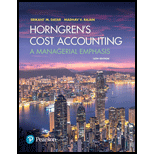
Manufacturing Companies:
Merchandiser is a person or organization who buys goods with the purpose of sale these goods to the customer. They buy goods either from the manufacturer or from a wholesaler. They sell goods at higher rate than its purchase price.
Merchandising Companies:
Merchandiser is a person or organization who buys goods with the purpose of sale these goods to the customer. They buy goods either from the manufacturer or from a wholesaler. They sell goods at higher rate than its purchase price.
Service-Sector Companies:
Service companies act as a service provider, who do not buy or sell goods. They deal with intangible things. Therefore, the accounts used by the Service Company differ.
To explain: The difference between manufacturing, merchandising and service-sector companies.
Want to see the full answer?
Check out a sample textbook solution
Chapter 2 Solutions
Horngren's Cost Accounting, Student Value Edition Plus MyLab Accounting with Pearson eText - Access Card Package (16th Edition)
- I need the correct answer to this general accounting problem using the standard accounting approach.arrow_forwardPlease show me the correct way to solve this financial accounting problem with accurate methods.arrow_forwardCan you solve this general accounting problem using accurate calculation methods?arrow_forward
- I need assistance with this general accounting question using appropriate principles.arrow_forwardgiven answer with calculationarrow_forwardAccounting records are maintained on a computer using proprietarysoftware.Your assistant is a newly recruited business graduate who has done an accounting course buthas no practical experience.Because of the small size of the company there is limited opportunity for segregation ofduties. You decide, as in previous years, that the appropriate audit strategy is to obtainevidence primarily through the performance of substantive procedures. You also plan toperform the audit around the computer as the proprietary software is known to be reliable anddetails of all transactions and balances can be readily printed out.On arriving at the company's premises in December 2019 to perform the final audit on the 31October 2019 financial statements, you obtain a copy of the year end bank reconciliationprepared by the bookkeeper and checked by the managing director. This is reproduced below. Balance per bank statement 31 October 2019: $36752.00Deposits outstanding:30 October…arrow_forward
- Can you solve this general accounting question with the appropriate accounting analysis techniques?arrow_forwardOn January 3, 2020, Lennox Corporation acquired equipment for $120,000. The estimated life of the equipment is 5 years, and the estimated residual value is $2,000. What is the amount of depreciation expense for 2021, if the company uses the double-declining-balance method of depreciation?arrow_forwardI am searching for the most suitable approach to this financial accounting problem with valid standards.arrow_forward
 Principles of Cost AccountingAccountingISBN:9781305087408Author:Edward J. Vanderbeck, Maria R. MitchellPublisher:Cengage Learning
Principles of Cost AccountingAccountingISBN:9781305087408Author:Edward J. Vanderbeck, Maria R. MitchellPublisher:Cengage Learning Managerial AccountingAccountingISBN:9781337912020Author:Carl Warren, Ph.d. Cma William B. TaylerPublisher:South-Western College PubPrinciples of Accounting Volume 2AccountingISBN:9781947172609Author:OpenStaxPublisher:OpenStax College
Managerial AccountingAccountingISBN:9781337912020Author:Carl Warren, Ph.d. Cma William B. TaylerPublisher:South-Western College PubPrinciples of Accounting Volume 2AccountingISBN:9781947172609Author:OpenStaxPublisher:OpenStax College Managerial Accounting: The Cornerstone of Busines...AccountingISBN:9781337115773Author:Maryanne M. Mowen, Don R. Hansen, Dan L. HeitgerPublisher:Cengage Learning
Managerial Accounting: The Cornerstone of Busines...AccountingISBN:9781337115773Author:Maryanne M. Mowen, Don R. Hansen, Dan L. HeitgerPublisher:Cengage Learning Corporate Financial AccountingAccountingISBN:9781305653535Author:Carl Warren, James M. Reeve, Jonathan DuchacPublisher:Cengage Learning
Corporate Financial AccountingAccountingISBN:9781305653535Author:Carl Warren, James M. Reeve, Jonathan DuchacPublisher:Cengage Learning





